
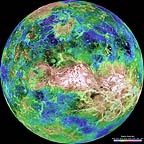 Although Venus is similar to Earth in
size, mass, and density, its surface environment is hostile, with
mean surface temperatures of 475 degrees Centigrade, a lack of
water, and a thick atmosphere dominated by CO2 gas. More than 98% of the Venusian surface has
been mapped at a resolution of about 100 meters by NASA's Magellan
mission in 1990 through 1994. Regional variations in surface height
are shown in the image left, where highlands
are depicted in white to tannish colors, uplands in greenish
colors, and lowlands in bluish colors. The entire surface
of Venus is younger than expected due to a massive resurfacing
event associated with flood basalt volcanism. These vast lava plains
are best preserved in the lowland regions. The relative ages of
impact craters on the lava plains suggest that this voluminous
outpouring of basalt could be as young as 300 million years ago,
or as old as 1600 million years ago. All of the well-developed
volcanic features discussed below appear to be younger than the
global resurfacing event.
Although Venus is similar to Earth in
size, mass, and density, its surface environment is hostile, with
mean surface temperatures of 475 degrees Centigrade, a lack of
water, and a thick atmosphere dominated by CO2 gas. More than 98% of the Venusian surface has
been mapped at a resolution of about 100 meters by NASA's Magellan
mission in 1990 through 1994. Regional variations in surface height
are shown in the image left, where highlands
are depicted in white to tannish colors, uplands in greenish
colors, and lowlands in bluish colors. The entire surface
of Venus is younger than expected due to a massive resurfacing
event associated with flood basalt volcanism. These vast lava plains
are best preserved in the lowland regions. The relative ages of
impact craters on the lava plains suggest that this voluminous
outpouring of basalt could be as young as 300 million years ago,
or as old as 1600 million years ago. All of the well-developed
volcanic features discussed below appear to be younger than the
global resurfacing event.
The lack of water erosion on Venus adds to the preservation of volcanic edifices on the planet's surface. Thus far over 1700 volcanic centers have been identified on Venus. These vary greatly in size, shape, and in the nature of eruptive activity. Most of these landforms can be subdivided into one of the following catagories: central-vent volcanoes, domes, ticks, calderas, coronae, and arachnoids.
Central-vent volcanoes are characterized by the radially dispersed lava flows extruded from near the summit of a well-defined, generally circular, volcanic edifice. These volcanoes are highly variable in size, although most have diameters <100 km. Most, but not all, of the Venusian volcanoes resemble shield volcanoes on earth. Two of the largest of these are Sif Mons (2 km high and 200 km in diameter) and Sapas Mons (1.5 km high and 400 km in diameter):
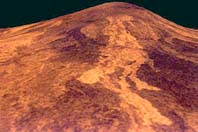
|
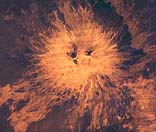
|
|
of Sif Mons |
of Sapas Mons |
Over 152 volcanic domes have been recognized on Venus. Most are circular in form and steep sided, with one or more summit craters and radial fractures. Their upper surfaces, however, vary from convex to exceptionally flat. Venusian domes are much larger than their terrestrial counterparts, with diameters ranging from 20 to 30 km and heights averaging about 300 meters. The flat-topped domes on Venus are sometimes referred to as pancake domes:
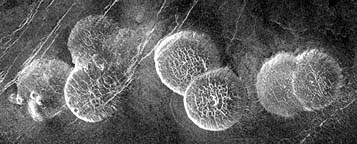
|
|
|
The composition of the domes on Venus is unknown. Although their smooth surfaces are consistent with basaltic compositions, their steep sides suggest that they are composed of viscous lava, consistent with high-silica, rhyolitic compositions. The concentric and radial fracture pattern shown by many domes (see above) is consistent with the stretching of dome surfaces during their formation as lava wells up from interior vents and spreads laterally on the surface.
 A group of enigmatic volcanic edifices,
referred to as ticks, are similar in some respects to volcanic
domes in that they are circular, steep-sided, and of similar diameter.
They differ, however, in their association with lava flows that
breach one or more sides of the structure. The west side of the
image shown here, for example, contains dark flows that emanate
from a shallow summit crater and traveled west along a lava channel.
The origin of these structures is not well understood. Ticks are
generally associated with rift zones. One theory suggests that
they are generated by dome formation within a rift, followed by
localized extrusion of lava along one of the rift fractures. Thus
far, about 50 such ticks have been mapped on the surface of Venus.
A group of enigmatic volcanic edifices,
referred to as ticks, are similar in some respects to volcanic
domes in that they are circular, steep-sided, and of similar diameter.
They differ, however, in their association with lava flows that
breach one or more sides of the structure. The west side of the
image shown here, for example, contains dark flows that emanate
from a shallow summit crater and traveled west along a lava channel.
The origin of these structures is not well understood. Ticks are
generally associated with rift zones. One theory suggests that
they are generated by dome formation within a rift, followed by
localized extrusion of lava along one of the rift fractures. Thus
far, about 50 such ticks have been mapped on the surface of Venus.
The term caldera is used here to describe circular to oblong depressions formed by surface collapse, similar to those found on earth. Like their terrestrial counterparts, they are associated with numerous, closely spaced ring fractures along the topographic rim of the structure. A total of 97 calderas have thus far been identified on Venus. Most range from 60-80 km in diameter, with depths up to several kilometers. In many cases, the caldera floors are covered with post-collapse lava flows.
Coronae are immense circular to oblong structures, generally between 200 and 250 km in diameter, although some can be as large as 1100 km across. These features appear to be unique to Venus. They have positive topographic expressions, with a surrounding moat or trough, and typical heights of more than 2 km above the surrounding plains. Their interiors, however, can be either topographically positive (dome-shaped) or negative (bowl-shaped). They are further characterized by closely spaced ring-shaped ridges or partially closed fractures. Radial fractures may also be present. The interiors of most coronae contain numerous, smaller volcanic features, such as lava flows, calderas, shield volcanoes, domes, and lava channels.
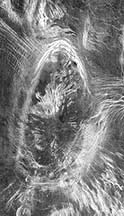
|
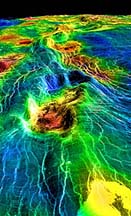
|
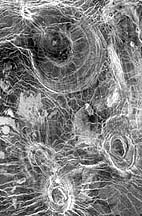
|
|
|
lowland plains |
|
The genesis of coronae appears to be associated with the arrival large mantle plumes beneath the Venusian lithosphere. The progressive evolution of these features involves both uplift and collapse, either concurrently, in sequence, or in cycles. Ring fractures develop as the surface bulges outward above the rising mantle plume, but subsequent relaxation of the uplift often results in collapse of the corona's interior along the concentric fractures. The abundant volcanic features found in the interior reflect melting of the plume head and subsequent extrusion of these melts at the surface. Thus far, 208 separate coronae have been identified.
Arachnoids are smaller than most coronae, but have a similar genesis. They features differ from coronae in that they contain a network of both radial and concentric structures that gives the appearance of a spider sitting on interconnected webs of bright lines, hence the name arachnoid, which is Greek for spider. The radial structures appear to be dike intrusions that stand out as ridges. Although it is thought that both coronae and arachnoids form in association with rising plumes of mantle, the magmatism associated with arachnoids may be largely intrusive, whereas magmatism associated with coronae is largely extrusive. There have been 265 arachnoids thus far identified on Venus.